2023 Pivot Mach 4 SL XTR XC vs DC version – One frame, two bikes?
With the new Mach 4 SL, Pivot killed two birds with one stone, releasing not one but two bikes at once: the new Mach 4 is available both as a short travel version with 104 mm rear travel, and a 116 mm long travel variant. At first glance, the bikes are nearly identical, which is reason enough for us to organise a shootout! Who came out on top in this brains vs brawn fight?

While Pivot Bikes might be better known for their fine trail, enduro and downhill bikes, the American brand also has a thoroughbred XC rig in its portfolio: the Mach 4 SL. While at first glance the latest iteration of Pivot’s XC bruiser hasn’t changed much compared to its predecessor, the new Mach 4 SL has been redeveloped from the ground up, and is now available in two versions. Tipping the scales at 10.8 kg, the World Cup variant combines 100/104 mm of travel front and rear and is the XC rocket in the Mach family. The Team Build, on the other hand, weighs in at 11.2 kg and generates 120/116 mm of travel front and rear, which makes it the optimal choice for downcountry and light trail riding. A flip chip in the upper shock mount allows you to reduce the rear travel by around 10 mm. Both variants retail at € 10,699 and share the same identical frame, which makes it extremely difficult to tell the two versions apart. But how does the different suspension affect the bike’s handling?

The new Pivot Mach 4 SL XTR 2023 in detail
With its unmistakable, square-edged frame silhouette and typical DW-Link rear suspension, the Mach 4 SL XTR is distinctly recognisable as a Pivot. The swingarm is a slender ensemble of thin tubes, and the seat stays merge seamlessly into the top tube, creating a single, straight line.
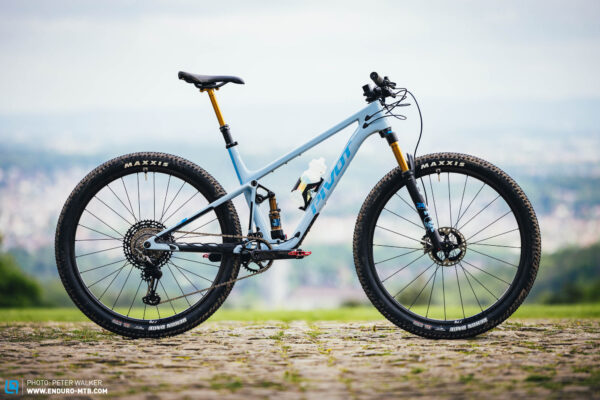
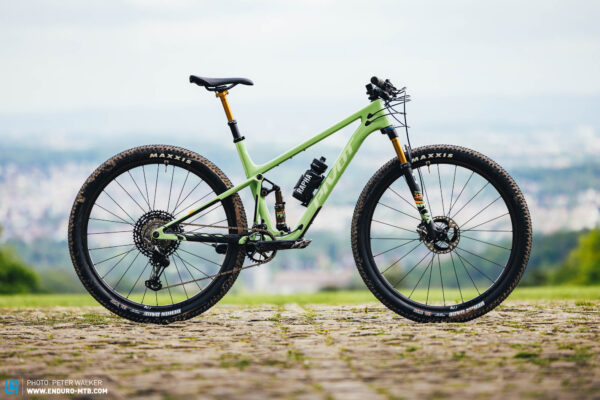
For the new frame, Pivot used an innovative, supposedly weight-saving manufacturing process and repositioned the rear brake mount, which is now tucked away behind the seat stay. To make this possible, Pivot’s engineers had to resort to a rather distinctive kink in the seat stay. There’s also a brand new service port on the bottom of the down tube, just above the bottom bracket, making it easy to access and service the cables.
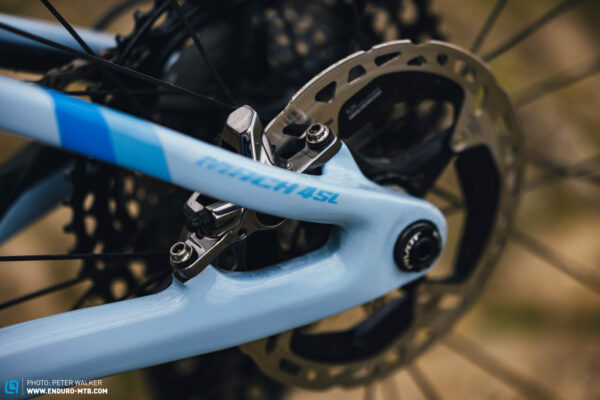
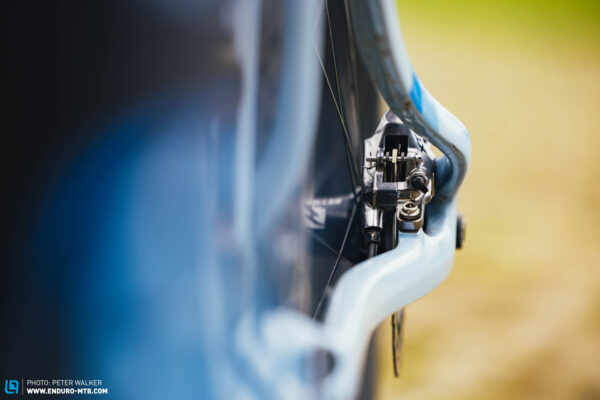
The frame has a total of six mounting points: three on the down tube, and three on the underside of the top tube. This allows you to change the position of the down tube bottle cage, as well as giving you the option to fit a tool strap, frame bag or second bottle cage under the top tube. Pivot swim against the growing trend of headset cable routing, relying on a more traditional internal cable routing system instead, with the cables disappearing into the frame through the headtube. There are two cable ports on each side of the frame, so you can choose which side to thread your rear brake line through. The ports are securely clamped, and prevent the cables from rattling on the trail. The chunky, ribbed chainstay protector could be taken straight from an enduro bike, and ensures a quiet ride.
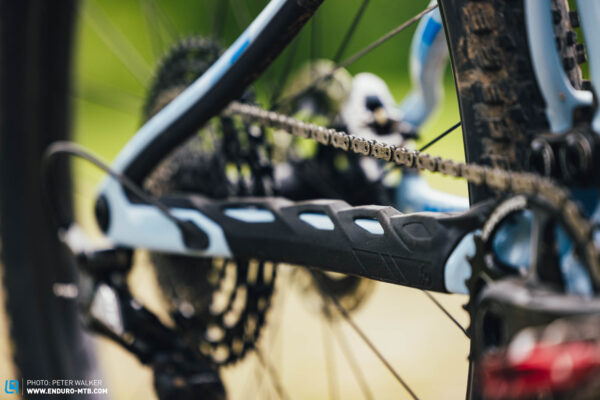
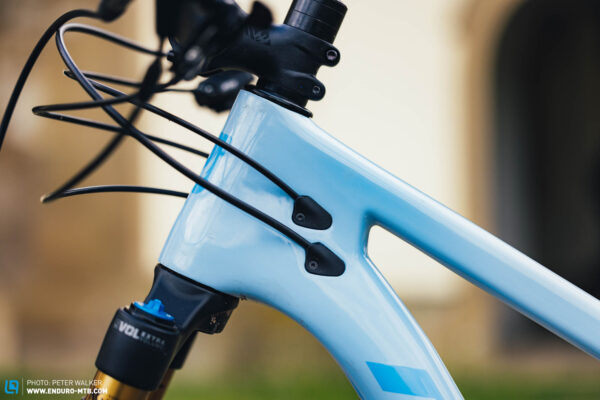
Specs and variants of the new 2023 Pivot Mach 4 SL
The Pivot Mach 4 SL is available in four build variants: Ride, Pro, Team and World Cup, all of which have a choice of either Shimano or SRAM components. This makes for a total of eight versions. The entry-level Ride Build retails at € 6,799 and comes equipped with a Shimano XT/SLX drivetrain and matching SLX brakes. Its SRAM counterpart costs € 7,299 and features a mixed X01/GX drivetrain and SRAM Level brakes. Both the Team Build and our World Cup Build test bike retail at € 10,699 and are specced with Shimano components. If you want SRAM’s new Transmission drivetrain and SRAM brakes, you’ll have to get the € 12,599 Team Edition, while the short-travel World Cup build costs slightly less at € 11,999. The entire 2023 Mach 4 range relies on FOX suspension, and the frames come in two pastel finishes with rather fancy names – Seafoam Green and Ice Blue.
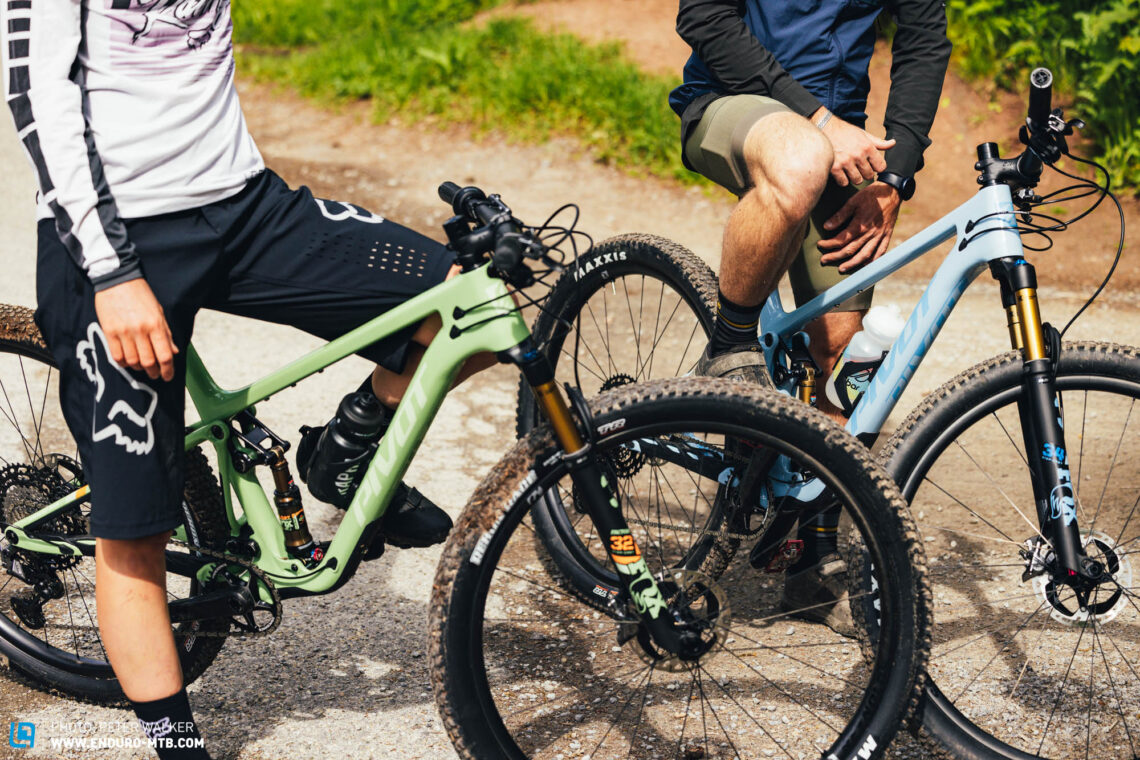
The spec of our 2023 Pivot Mach 4 SL XTR models
Our two Pivot Mach 4 SL test bikes share near identical specs, with the only difference being the suspension and dropper post – albeit both supplied by FOX. A nice little detail: like all Pivot bikes, the Mach 4 SL comes standard with a small sag indicator on the shock, which makes it easier to set up the suspension. The ST model employs a 32 mm Factory Step-Cast fork and matching FLOAT SL Factory shock. The Transfer SL dropper is lighter than the standard Transfer, but only offers two positions – slammed or fully extended. In addition, it only has 100 mm of travel, restricting freedom of movement on the bike. The Team Build comes equipped with a FOX 34 Factory Step-Cast fork and a slightly beefier FOX FLOAT shock. While the fork’s 34 mm stanchions are burlier, they’re paired with a lightweight, tapered Step-Cast lower leg assembly, reducing the available space for the spring and damper. Unlike its lightweight SL counterpart, the FOX Transfer dropper is infinitely adjustable and also offers more travel at 125 mm which, while still meagre, allows for more freedom of movement on the trail.
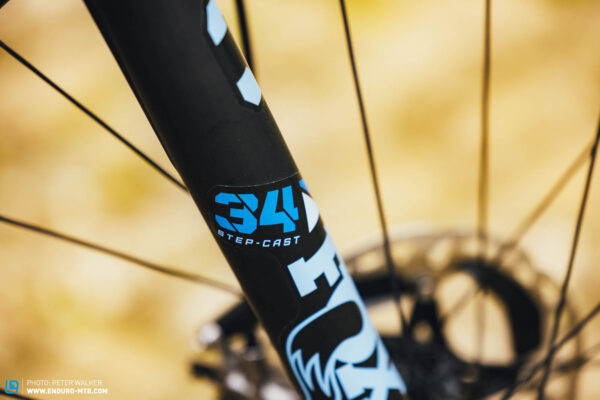
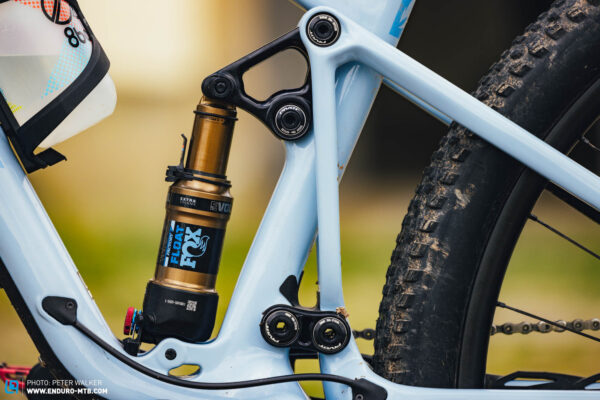
Both Mach 4 variants feature a twist grip lockout on the left side of the handlebars. On the Long Travel model, this lets you switch between open mode and platform damping on the shock. The World Cup Build, on the other hand, features a three-stage lockout system that allows you to switch between a fully open mode, platform damping and lockout, both on the shock and fork. While the twist grip saves you a lever in the cockpit, it’s rather bulky, limiting the adjustment options for the brake levers. For the rest of the spec, the two bikes rely on the same components, including Pivot’s in-house 60 mm alloy stem and 760 mm carbon handlebars. However, the additional cables of the lockout lever make for a rather crowded cockpit, especially on the ST model, which employs an additional fork lockout remote.
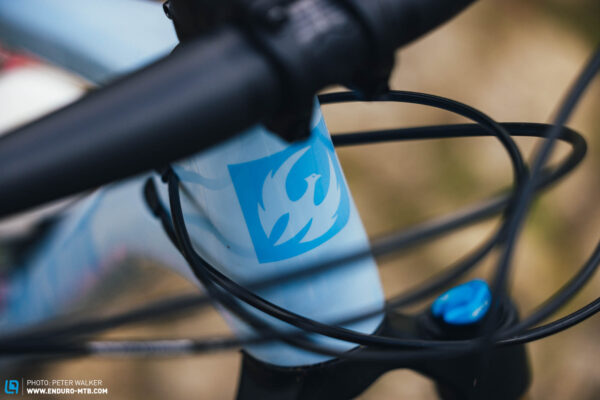
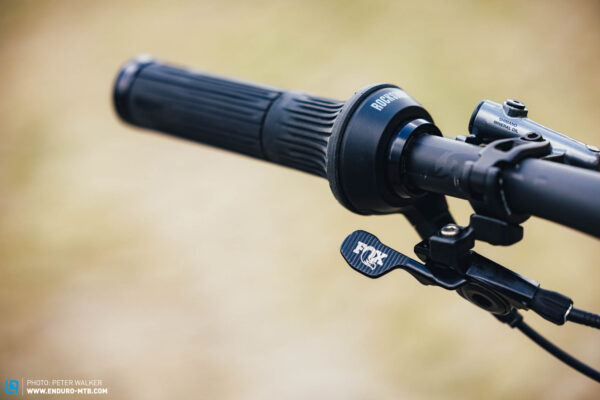
As the Mach 4 XTR name suggests, Shimano supply a top-tier 12-speed XTR drivetrain and matching two-piston brakes. These are paired with 160 mm brake rotors front and rear, which are small compared to what we’re used to seeing around here, but still big enough for most trail scenarios and the Mach 4’s intended use. That said, heavier riders and those spending lots of time on steep, long descents, should upgrade to bigger rotors. Swapping the stock rotors with 180 mm discs front and rear only adds about 125 g. Our test bike comes with a Reynolds wheelset, but the Mach 4 models intended for the German market will likely come equipped with a NEWMEN wheelset. Interestingly, the Mach 4 uses Boost rather than Superboost, unlike some of the burlier bikes in the range. According to Pivot, not only do the narrower hubs save weight, but also suit the bike’s field of application better, which doesn’t require the additional stiffness of wider Superboost wheels. The wheels are paired with 2.4” MAXXIS Rekon Race tires in EXO casing and DualCompound. The latter suits the character of the bike, keeping both rolling resistance and weight penalty to a minimum. In muddy conditions, however, the shallow profile quickly reaches its limits. Furthermore, MAXXIS’ new MaxxSpeed rubber compound would deliver a better overall performance on the trail.
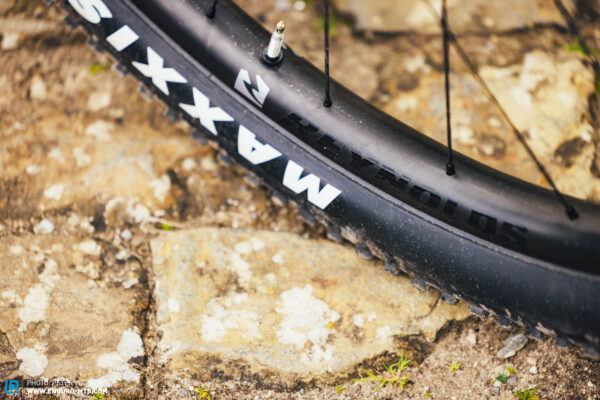
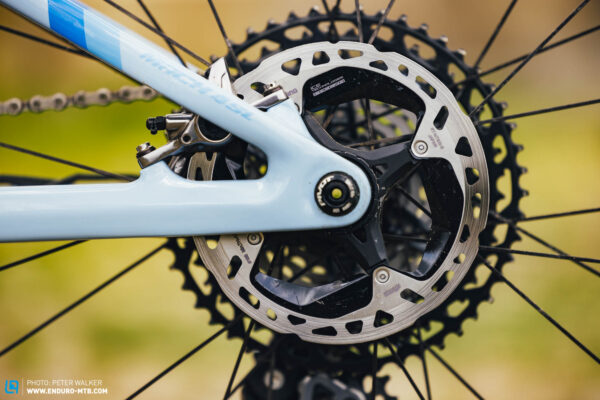
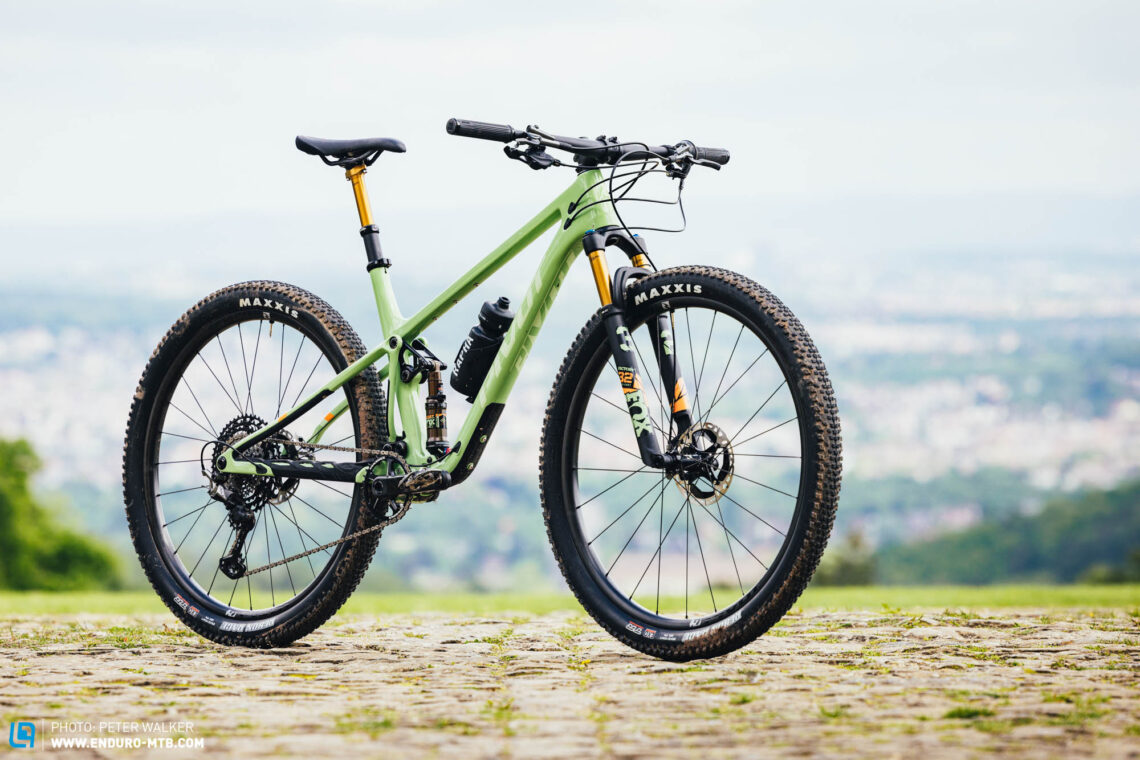
Pivot Mach 4 SL World Cup
Specifications
Fork FOX 32 Factory Stepcast 100 mm
Rear Shock FOX Float SL Factory 104 mm
Seatpost FOX Transfer SL 100 mm
Brakes Shimano XTR 160/160 mm
Drivetrain Shimano XTR 1x12
Stem Pivot 60 mm
Handlebar Pivot Carbon 760 mm
Wheelset Reynolds Carbon 29"
Tires MAXXIS Rekon Race, Dual Compound, EXO/MAXXIS Rekon Race, Dual Compound, EXO 2.4"/2.4"
Technical Data
Size XS S M L XL
Specific Features
Tool Mount
Flip Chip
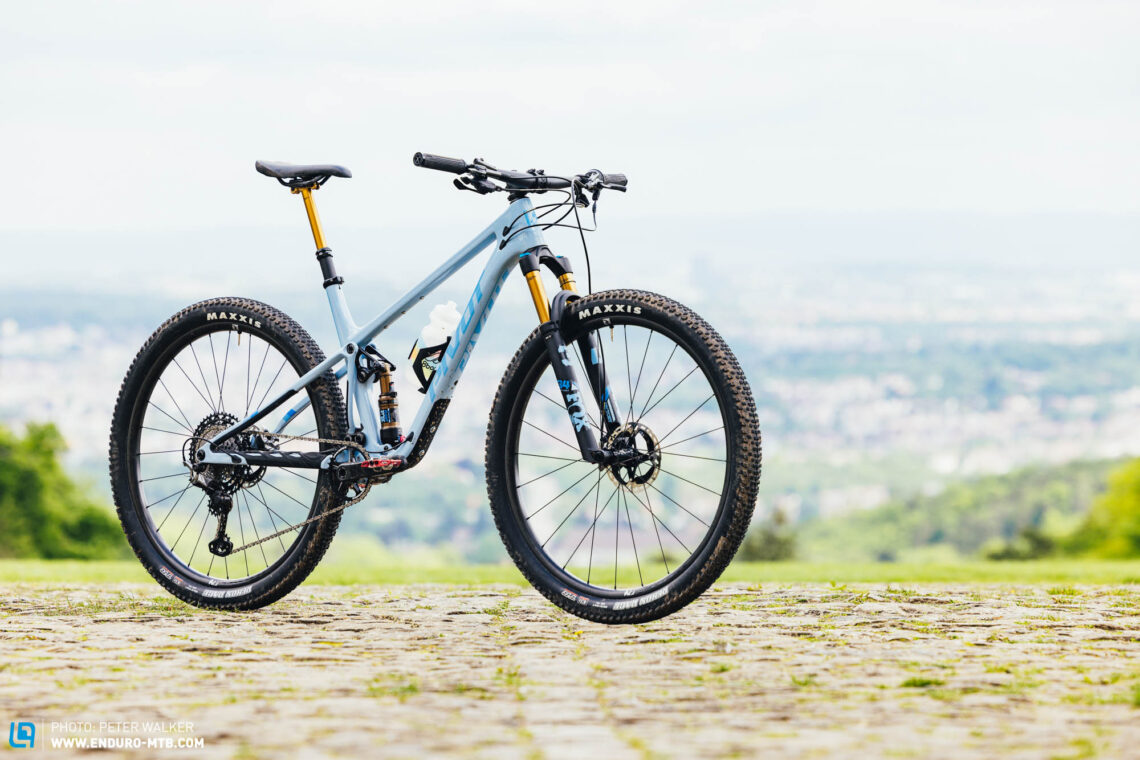
Pivot Mach 4 SL Team
€ 10,699
Specifications
Fork FOX 34 Factory Stepcast 120 mm
Rear Shock FOX Float SL Factory 116 mm
Seatpost FOX Transfer 125 mm
Brakes Shimano XTR 160/160 mm
Drivetrain Shimano XTR 1x12
Stem Pivot 60 mm
Handlebar Pivot Carbon 760 mm
Wheelset Reynolds Carbon 29"
Tires MAXXIS Rekon Race, Dual Compound, EXO/MAXXIS Rekon Race, Dual Compound, EXO 2,4"/2,4"
Technical Data
Size XS S M L XL
Specific Features
Toolmount
Flip Chip
The geometry of the new 2023 Pivot Mach 4 SL
The Pivot Mach 4 SL is available in five sizes, XS to XL. Despite using the same identical frame, the two bikes have different geometries due to the different amounts of travel. In size L, the long travel model has 462 mm reach and 617 mm of stack, while the short travel model has a racier 475 mm reach and 608 mm stack. Both variants share the same, long 460 mm seat tube. However, a shorter seat tube wouldn’t really make much sense in conjunction with the stock, short-travel dropper posts. Chainstay length is 432 mm across the board, and a flip chip in the upper shock mount allows you to reduce rear travel from 116 to 104 mm on the long travel variant, and from 104 mm to 95 mm on the short travel bike.
The geometry of the new Pivot Mach 4 SL (104mm)
| Size | XS | S | M | L | XL |
|---|---|---|---|---|---|
| Top tube | 565 mm | 580 mm | 609 mm | 638 mm | 662 mm |
| Seat tube | 355 mm | 394 mm | 419 mm | 460 mm | 505 mm |
| Head tube | 55 mm | 90 mm | 105 mm | 120 mm | 135 mm |
| Head angle | 68° | 68° | 68° | 68° | 68° |
| Seat angle | 76° | 76° | 76° | 76° | 76° |
| BB Drop | 47 mm | 45 mm | 45 mm | 45 mm | 45 mm |
| Chainstay | 432 mm | 432 mm | 432 mm | 432 mm | 432 mm |
| Wheelbase | 1,101 mm | 1,118 mm | 1,149 mm | 1,179 mm | 1,205 mm |
| Reach | 410 mm | 425 mm | 450 mm | 475 mm | 495 mm |
| Stack | 577 mm | 580 mm | 594 mm | 608 mm | 622 mm |
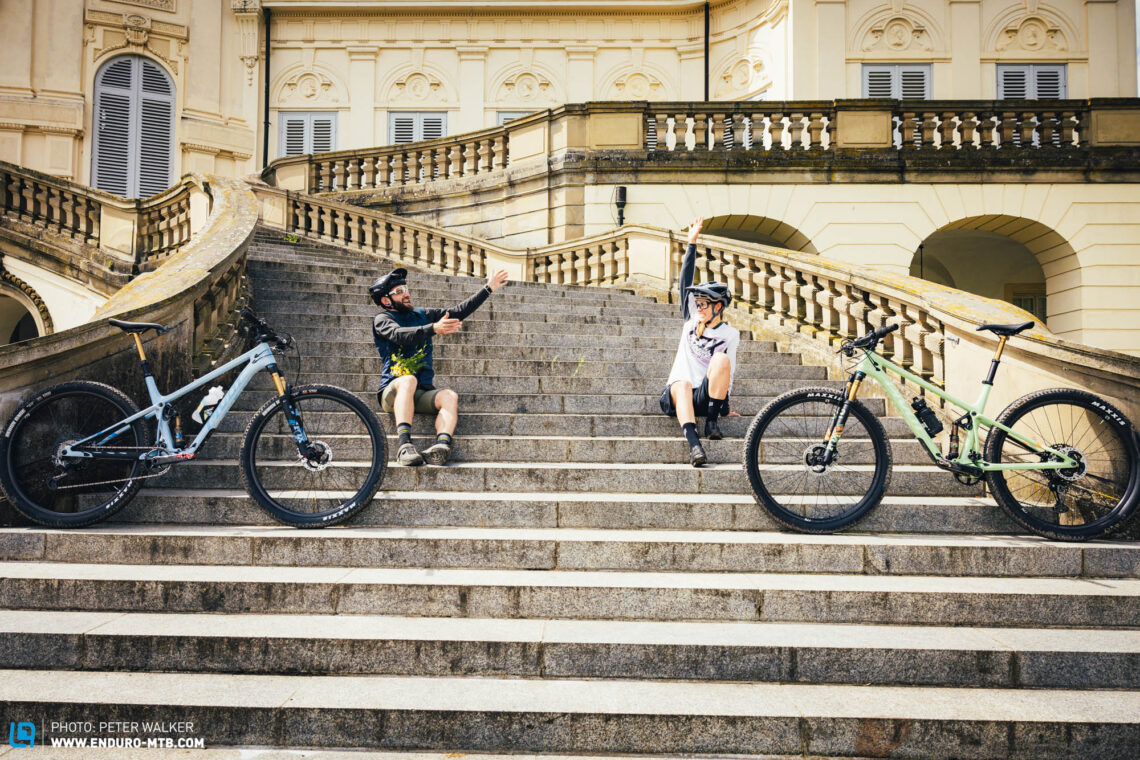


The new 2023 Pivot Mach 4 SL XTR models on the trail – What are the biggest differences?
In order to work out the differences between the two bikes, we rode the ST version with the flip chip in the short setting, which reduces rear travel from 104 mm to 95 mm. When you swing your leg over the saddle, the two Mach 4 SL XTR variants feel very similar at first. The pedalling position is clearly front-heavy and puts plenty of pressure on your hands on level ground. In a nutshell, the Mach 4 doesn’t want to be a comfortable tourer, and it isn’t. Instead, it encourages you to push hard uphill with its sporty riding position. When climbing, the Pivot places you in a central, comfortable pedalling position, with the weight evenly distributed between the front and rear. This ensures plenty of traction at the rear and at the same time keeps the front wheel planted on the ground, ensuring excellent traction upfront. On steep climbs, however, the slack seat angle pulls you far back over the rear wheel, causing the front end to lift off the ground easily, especially with a rough, stompy pedalling style, thus forcing you to actively weight the front wheel.

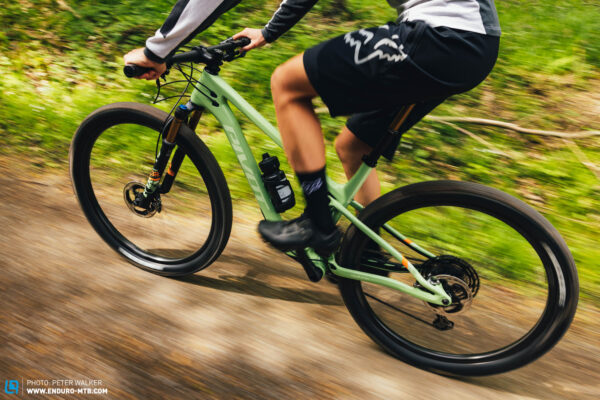
When performing your typical car park bounce-test, the suspension feels rather soft, but it stiffens up noticeably as soon as you put some tension on the chain, even with the shock in open mode. However, long climbs and uneven pedalling cadences call for the climb switch, which can be activated quickly and easily using the twist grip without having to remove your hands from the handlebars. In the first mode, the rear suspension is much more composed but bobs noticeably when pedalling hard. With the World Cup Build, you can lock out the suspension completely, preventing the shock and fork from moving at all, even when sprinting out of the saddle. Needless to say, this comes at the expense of comfort and traction in technical sections, because the tires quickly lose contact with the ground in rougher sections.

Taking the different lockout systems out of the equation, the two Mach 4 SL XTR models deliver a comparable climbing performance and offer a very similar ride feeling. However, this changes rapidly as soon as gravity takes over. Downhill, the short travel variant is stiffer and more direct, placing you on top of the bike rather than integrating you between its wheels. This feeling is intensified by the short-travel dropper post, which causes the saddle to get in your way. Astride the World Cup Build, you’re constantly reminded that you’re riding a cross country rig that was trimmed for maximum efficiency. On flowing trails, it provides tons of feedback from the ground and makes it easy to generate speed by pumping through rollers and berms – and the short travel variant also makes it easy to sprint out of flat corners at Mach 10. When the trail gets rougher, however, Pivot’s mean XC machine quickly reaches its limits, losing traction far too easily, even in short rough patches. Needless to say, this requires a more vigilant riding style, especially in fast, demanding sections.

Despite using the same frame, the Team Build descends more like a mini-trail bike than an XC rig. The suspension is noticeably plusher and provides less direct feedback on flowing trails. At the same time, it’s noticeably more defined, letting you know clearly when it’s compressing and when it’s bouncing back at the exit of a corner. This, too, makes it easy to generate speed when pumping through rollers. The plushness of the suspension keeps the rear end planted on the ground, inspiring significantly more confidence in fast sections. A fun rocket on flowing trails! When the going gets rougher, the long travel Mach 4 SL XTR is noticeably more composed, generating more traction and thus ensuring better control – the longer dropper helps too, providing more freedom of movement on the bike. As a result, it encourages you to commit to faster, bolder lines more than its little brother. Of course, the Pivot is still a rather conservative 120 mm downcountry bike, meaning that it quickly reaches its limits on demanding terrain.

Both bikes share a common problem: the fork doesn’t offer enough mid-stroke support, which becomes particularly evident in compressions and with bigger jumps, where both forks rush through their travel rather abruptly. This throws you off balance and pulls you even further over the low front end, putting you in a super stretched, rather sketchy riding position, especially on very steep descents.
Who should take a closer look at the 2023 Pivot Mach 4 SL XTR and which one should you pick? Short travel or long travel, that’s the question!
The short travel variant of the Pivot Mach 4 SL XTR is an XC racer for KOM hunters and riders looking for maximum efficiency, which obviously comes at the expense of trail performance.
The Mach 4 SL XTR long travel version, on the other hand, is aimed at sporty riders who like to ride fast but want to have fun without hunting KOMs. If you want to push your limits on demanding trails in true “underbiked” style, the Pivot is a great option too.

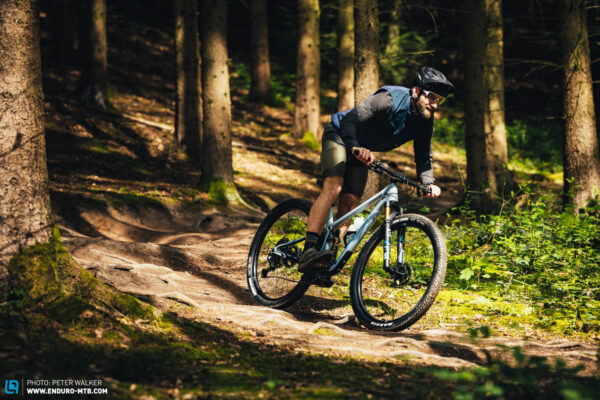
Our conclusions about the new Pivot Mach 4 SL
So similar and yet so different! The two variants of the new Pivot Mach 4 look almost identical and share the same frame details, which makes it hard to tell them apart at first. However, the short travel variant is direct, efficient and lively uphill, but feels stiffer and slightly more nervous downhill. The long-travel version, on the other hand, stays behind uphill but is much plusher on the trail, inspiring far more confidence and delivering a much higher fun factor in the process.
Tops
- Versatile frame platform
- Slender frame silhouette
- Quiet downhill
Flops
- Shallow-profiled tires quickly reach their limits in muddy conditions
- Fork lacks mid-stroke support
Tuning tips: Bigger brake rotors for heavy riders and long descents
For more info, visit Pivot’s website.

